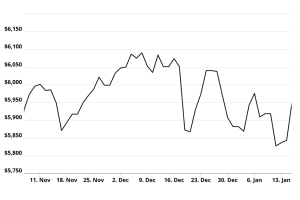
Bullish sentiment is soaring … but we still have a flagging U.S. consumer … “none and done” for 2024 rate cuts? … Louis Navellier’s AI warning
Older investors will recall this infamous cover of BusinessWeek from 1979. The title declares, “The Death of Equites.”

The cover reflects what had been a brutal run for the stock market since the early 1970s.
Long-term investors had been destroyed. The price return from early 1973 through this cover story in August of 1979 was a loss of nearly 17%.
Good luck retiring on that.
However, had an investor used this magazine cover as a contrarian “buy” signal, he would have been rewarded with 17.4% annual gains for the next two decades. That’s a cumulative 2,375% returns, turning $20,000 into almost half a million dollars.
Bottom line: Beware extreme investor sentiment. It’s often precisely when the market begins shifting in the other direction.
With this in mind, here’s what I stumbled upon yesterday morning
It doesn’t carry the same gravitas as a BusinessWeek cover, but you’ll get the point…

If you can’t see the image, we’re looking at a bear on life support in a hospital. Behind him is an unyielding bullish stock chart.
We’re seeing this rampant, gleeful bullishness everywhere today.
For example, the put-to-call ratio just fell to 0.44, the lowest level since July of 2023. It’s also the second-lowest level since March of 2022.
If you’re less familiar with options, investors typically buy puts when they’re feeling bearish and calls when they feel bullish. So, this ratio is telling us that bullish investors have the least interest in hedging their portfolios in years.
And why should they?
The S&P has racked up 45 all-time highs in 2024… it’s having its best year-to-date performance of entire millennium… and it has launched the value of the median U.S. household stock portfolio to $250,000, which is almost twice where it stood in early-2023.

Bottom line: Bulls are partying… fear is fading as portfolios swell… and once again, FOMO is becoming the driving emotion of the market.
If you listen closely, you can almost hear Warren Buffett whispering “be fearful when others are greedy.”
Now, let me quickly push back against myself…
Yes, today’s market is expensive. If you’re a regular Digest reader, you’ve seen me provide a variety of indicators and ratios illustrating this in recent weeks/months.
However, that doesn’t mean that we’re near a top. And even if we are, a study of market history reveals that the biggest gains often come at the end. For example, between October 20, 1999, and March 9, 2000 – just 141 days – the Nasdaq soared 88%.
We want exposure to the possibility of such a surge. And if it turns out that we’re years away from a top, well, we want exposure to those gains too.
As we frequently write in the Digest, price is truth. If the market wants to climb higher, that’s all that matters as far as our portfolio value is concerned.
But everyone in this market should have a healthy respect for risk. After all, if we know anything, it’s that a more realistic graphic than the sickly bear above would be that of a hibernating bear who, eventually, is going to wake and come out hungry and angry.
With this in mind, as Americans with stock portfolios are partying, what red flags do we need to consider as we keep riding this bull?
Well, let’s begin with some symbolism.
Below, we compare the two-year charts of Ferrari in black and Dollar General in green.

Ferrari is up 162%. Dollar General has lost 65%.
This is just another visual on a point we’ve made many times this year – we have a K-shaped economy and consumer today. Some folks are doing great while others are struggling.
How close are we to this mattering for the stock market?
Before we address that, let’s get a sense for how “Dollar General” America is holding up.
A quick tour through America’s wealth statistics
In 2022, 58% of Americans reported living paycheck-to-paycheck. As of August, that number had jumped to nearly 66%. And it’s not just low-income Americans.
MarketWatch reports that 48% of people earning $100,000 are living paycheck to paycheck, as are 36% of those earning $200,000 or more.
Meanwhile, in August, the New York Fed reported that credit card debt just hit a record $1.14 trillion. Delinquency rates are rising with 9.1% of credit card balances transitioning into delinquency over the past year.
According to the New York Fed’s September 2024 Survey of Consumer Expectations, consumers see an increased probability of missing debt payments in the next 3 months – the highest level since April 2020.
Half of Americans now carry a credit card balance, which is awful because the average credit card interest rate is 24.72%, according to Lending Tree.
As you’d image, Americans aren’t saving as much. As of August, the personal savings rate was 4.8% compared to the long-term average of 8.5%, according to YCharts.com.
Yesterday, Edmunds reported that the number of Americans with auto loans who owe more than the value of their vehicles are worth has climbed to 24.2% in Q3. The report states, “Consumers who are underwater on their car loans owe more money than ever before.”
This comes after a Federal Reserve report in September finding that delinquency rates on auto loans rose substantially above pre-Covid pandemic levels to end 2023.
We could go on, but you get the point. Half our nation is struggling to keep its head above water.
So, when will this impact the Ferrari Americans with their surging portfolio values?
That’s tough to answer for all sorts of reasons, chief among them is the Fed.
Today’s going market narrative is “the Fed has begun to cut rates… loads of rate cuts are coming… they’ll spur economic growth and provide breathing room to low-income Americans… let’s load into stocks today in anticipation of the boom tomorrow.”
But how certain are we about the whole “loads of rate cuts are coming”? After all, that’s the lynchpin issue.
According to the CME Group’s FedWatch Tool, one month ago, traders put the odds of at least 75-basis-points of additional rate cuts by December at 64.1%. As I write Wednesday, those odds are now – wait for it – 0%.
Behind this recalibration is the payroll report that blew away expectations, plus a CPI report that showed inflation was hotter than expected. These are not conditions that demand loads of immediate rate cuts.
Cut to Federal Reserve governor Chris Waller on Monday saying:
Data is signaling that the economy may not be slowing as much as desired.
While we do not want to overreact to this data or look through it, I view the totality of the data as saying monetary policy should proceed with more caution on the pace of rate cuts than was needed at the September meeting.
Meanwhile, last week, Louis Navellier’s favorite economist, Ed Yardeni, said the Fed shouldn’t cut rates at all for the rest of the year.
In an interview on CNBC, Yardeni said that Powell’s 50-basis-point cut was too much for our resilient economy. Based on sticky inflation, he argued for, “none and done for the rest of the year.”
The interviewer’s response was simply, “Wow.”
Bottom line: If your investment thesis requires loads of rate cuts, be very careful.
So, what happens to the Dollar General Americans if the Fed slow-plays rate cuts?
Obviously, that keeps economic pressures high, they fall further behind, and increasingly close their wallets…which, if it continues, will eventually matter to the Ferrari Americans partying in the stock market.
Consider this…
When we’re looking at market performance over a year or less, the primary driver of a stock is emotion (the multiple investors are willing to pay). But the farther out you go, the less sentiment matters, and the more operational strength is the key driver. In this case, we’re talking about revenue growth.
You can see this in the chart below. On the left is the one-year driver of a stock price with sentiment in red (at 46% of the driver of a stock price) and revenue growth in blue (at just 29%).
But see how this flips the farther out you go.

Over the last two years, bullish Ferrari Americans have helped push the S&P to one of its best runs ever due in large part to sentiment.
But if we want this market to continue climbing in a healthy, sustainable way, earnings must roar higher to do their part too.
To be fair, earnings have been climbing…but not nearly enough to match sentiment. For example, last year, the S&P climbed 24%. Earnings only rose 2%.
We’re seeing stronger earnings growth this year, but still at a pace below growth from sentiment. Bottom line: earnings matter…which means the Fed’s rate-cut policy matters.
One of the best things we can do for our portfolios is to focus on where earnings are most likely to remain strong – regardless of what the average stock does
After all, as we often write in the Digest, the market is not one huge monolith that rises and falls in unison. It’s made up of thousands of different stocks that perform wonderfully and poorly at different times, for different reasons, and in different market environments.
So, what corner of the market is setting up to “perform wonderfully” with the help of robust earnings growth?
That’s what legendary investor Louis Navellier is focusing on today, and that has him looking at AI. But please understand – it’s not all AI stocks.
AI implementation matters. Cost savings matters. Revenues matter. Return on investment matters.
As you saw above, in the short-term, hype can take you far, but in the longer-term, substance matters.
Louis, whose entire market approach is based on substance – meaning fundamental strength as evidenced by his quantitative approach to the market – is worried that investors are missing the most important evolution within the AI sector today:
I predict AI stocks will see a massive shift, beginning by October 21.
But not in the way you might expect…
In short: You have just days left to prepare for a sudden change in the stock market that could double your money 6 different times – without putting a penny into Nvidia or any other popular AI stock.
That’s a bold claim, and I don’t make it lightly.
But the fact is, I’ve already seen up to 37,000% gains on my Nvidia recommendation, which I consider an “old story” at this point.
Back in June, I shared a new way of playing the AI boom which has already shown us massive gains. For example, you could have more than doubled your money on an AI energy stock I recommended.
But that’s only the beginning, which is why, today, I’m sounding the alarm.
Louis goes on to point out that he’s seeing a lot of people acting foolishly in the AI space, or he’s seeing nervous investors hiding out in Treasury bills.
Neither is the right approach. Louis has put together a presentation highlighting a better way to be in AI.
It’s a way to help sidestep the core challenge of our Digest today. So, rather than be worried about the health/longevity of today’s bull market… or our K-shaped economy… or what happens with the Fed and interest rates… let’s focus on where the strength will continue as we push into 2025. And one of the answers is top-tier AI stocks with substance.
Here’s Louis’ take:
Recklessly investing in “the first generation” of AI stocks is going to cost you dearly in exactly the kind of financial shift I’ve spend my 47 years on Wall Street predicting again and again.
But the fact is, if you know what’s coming, and what to do, it will be among the best opportunities in 2024 to make serious gains, faster than you can imagine.
Again, to access Louis’ research, click here.
Wrapping up, bullish sentiment continues to dominate so let’s keep making money…
But be aware of the shifting dynamics underneath this surging market.
That sickly bear isn’t down for the count.
Have a good evening,
Jeff Remsburg




